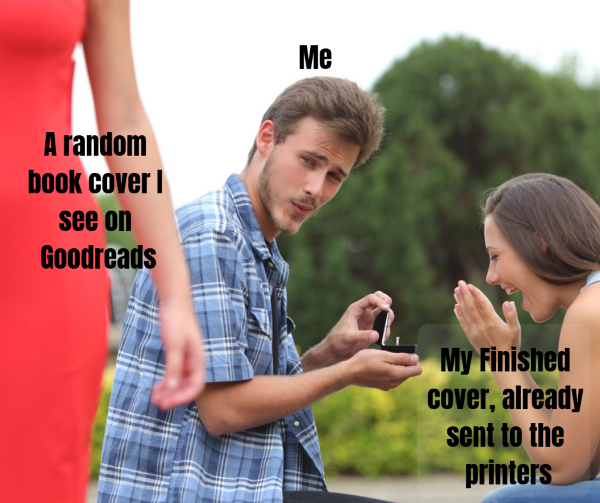Cover design is an area that many self-publishers struggle with, particularly educators who want to self-publish for the first time. Book design is not always in our skill set and designing a cover for a book generally requires graphic design software such as Photoshop. These programs can be intimidating to the novice. Now, does a cover really matter to the success of your book?
You probably know the saying “Don’t judge a book by its cover.” While this is a good principle for many things in life from other human beings to new experiences, it doesn’t actually apply to books. There’s plenty of reason to believe that we DO judge books by their covers!

I don’t know if a good cover can necessarily make a book sell, but a bad cover can definitely ruin a good book. And a cover is the first thing anyone will see of your book. If it’s off-putting, it may be the only thing they see!
So what constitutes a good or bad book cover? It depends on the genre. Take a moment to go to your bookshelf and pick out a few books in the same genre. You can do this with any genre of book, fiction or non-fiction. However, since this article series is focused on helping teachers self-publish, try to find some ELT books. Pick out some textbooks, then some teacher resource books, graded readers, and activity books for young learners (or teens or adults or whatever demographic you have). Chances are the books across the genre look very similar or at least have some similar features.
All that is to say that cover design is something that you should take seriously. However, an ELT book cover is rarely as elaborate as the cover for a fantasy novel. If you’re really on a budget there are a few other options for creating a cover that looks nice yourself.
Do Your Research
The first step to cover design is to do some research (and this is what a professional cover designer will do). Go back to your shelf, visit a library, or get on a bookstore website and take a good look at the covers in your area. Look for things like:
- What’s the overall layout?
- How many colors are used and what kind of palette are they from?
- What is the background? Is it an image, a collage of pictures, a solid color, an abstract pattern, or something else?
- What images are used? What do they generally show? What style are they in? How are they arranged?
- Are the images color or black and white? Are they blurred or have other filters on them?
- Where are the title, subtitle, author, any series title, levelling info placed? What kinds of fonts are they in? How big are they?
- What’s the general style and overall look?
- What elements do you notice? Is the title usually in a colored text vox for example?
Use your research to form an idea of what you want your cover to look like.

Designing an ebook cover is simpler because you only need a front cover. If you’re working on a print book, then you should go to your printer and download a cover template. KDP has a cover generator here and Ingram Spark’s template for print book is here. You can also visit bookow.com for cover templates as well as barcodes for free (donations highly recommended). Notice that you’re going to need to have a finished interior before you can download the template because you need to know how many pages your book is. That determines the width of the spine.
I designed this cover by looking by creating a template over an existing cover I liked and then tweaking it. Now let’s look at some ways to create covers from the simplest and cheapest to the most expensive or elaborate.
Image and Text
There are a surprising number of educational covers out there are a background such as a stock photo or abstract background with the title and author name placed over it. Sometimes you’ll see an image on the top and a solid block of color for the title and author beneath. Or the image is on the bottom and the text is on the top. I discussed websites where you can get art in another post. Paid stock photo sites usually have backgrounds and abstract patterns that look nice on a book cover. They also have icons and decorative elements that can give your cover a little flair. If you’ve used mostly free art for the interior, the cover is a good place to splurge on an image that you really love.
You can put something like this together in a simple art program, or even an online program like Canva, Snappa, or Adobe Express. Just make sure your image is the correct size. If it’s a print book, follow the template. If you’re doing an ebook, a good rule of thumb is 1600 pixels x 2560 pixels, saved as a JPG with a minimum of 192 ppi (pixels per inch) resolution although modern devices are higher resolution so you can go up to 300 ppi. When in doubt, you can also check with individual distributors as to their requirements.
Of course, if you have expertise in a program like GIMP, Photoshop, Affinity Design or Publisher, or Adobe InDesign, do your cover that way. The level of control you’ll have will be much higher and you can create a wonderful cover. If you’re doing a paperback cover, then you’ll have to use a professional-level program anyway.
Templates
Graphic design websites such as Canva or Adobe Express also have book cover templates that you can work with. Be sure to choose one appropriate to the genre. I love some of Canva’s haunting covers but they are better suited to a thriller than a grammar book! Also be sure to adapt the cover. Use your own art, change the color scheme, and maybe even invert the layout. Make it original so it stands out.
KDP and some other book distributors also have book creation software built into the website. The biggest benefit of these templates is you don’t have to worry about what to put on the back cover and how to lay it out. You choose your template, add your art, select fonts and colors, then enter your text in the correct place. Best of all, it’s free if you’re uploading your book to that site. This really is the cheapest and easiest way to get a paperback cover that will meet the technical requirements and can look very nice!
Even if you are a professional using Adobe InDesign, you can still work to a template. I often download a cover I like and create a template off of it, borrowing the elements that work. There are also websites that sell templates for InDesign or Photoshop including CreativeMarket.com, Adobe Stock or even Etsy. You can download a file at a very reasonable price, open it in your design program, and customize it to your liking.
Get a Pro
Getting a professional to do a cover for you is always a good idea, particularly if you are doing a paperback book which requires a back cover, front cover, and possibly a spine.
If you’ve hired an interior designer, you may want that same person to do your cover. Many book designers do both and having the same person design the interior and the cover ensures consistency in the design and the aesthetic. However it isn’t necessary, and a professional designer will be able to use someone else’s design elements without any trouble.

As with editors or any other service in life, you get what you pay for when it comes to designers. A good cover designer is up to date on current design trends. They will do thorough research, develop several options for you, and go through multiple rounds of feedback and revision. Some designers can create original art or even custom fonts.
You can also find cover designers to fit a smaller budget. They may offer fewer options and the overall look may be less sophisticated and detailed, but you’ll still end up with a professionally designed cover and it will show!
When working with a professional, they will need to know:
- Where you plan to publish your book and in which formats.
- The size, called the trim, of the book.
- Exactly what text you want on the cover: title, subtitle, author name (written exactly how you want it to appear), any other text.
- The genre of book.
- The audience.
- If you’re doing a paperback book, you’ll need to know what you want on the back cover. At a minimum you need a description of the book and blurbs or reviews you want to include. You might also need an author photo, bio, website, logo and so on.
Designers also like some inspiration from the client. Feel free to share any of the following (which many designers will explicitly ask for).
- Any book covers that you particularly like.
- Colors or elements that you have in mind.
- Anything you definitely don’t want in your book.
Fiverr and Reedsy are great places to find good designers. You can also search LinkedIn or tap your networks. A surprising number of people have graphic design skills these days and you may know someone who is willing to work for you at a friends and family discount or barter their cover design skills.
50 Activities for the First Day of School was designed by Dick Margulis and Classroom Community Builders was my first self-designed cover. What differences do you notice?
Cover design is a large topic. There’s a never-ending list of things to know about file size and requirements, design theory and book conventions, elements such as fonts, colors, and shapes, and more. However, it’s also a lot of fun. One of my favorite parts of book design is working with different options for covers and choosing between them, then tweaking the original design to see how even a small thing can breathe new life into a design.
As always, I’d love to hear more about your book design advice, as well as challenges and triumphs! Leave a comment, tell me what you want to know more (or less) about!
And if you feel overwhelmed, feel free to get in touch. I’d love to design a cover for you or help steer you in the right direction to the cover of your dreams.

